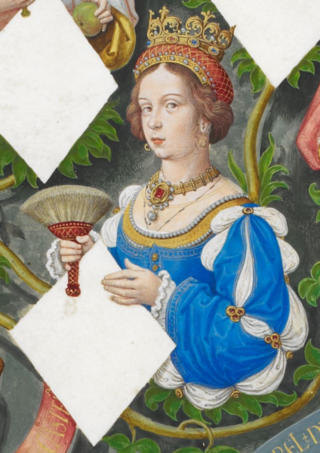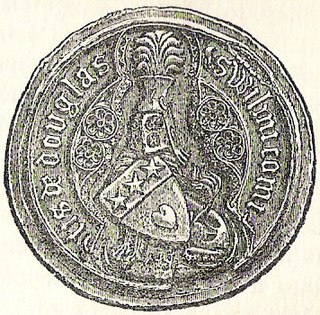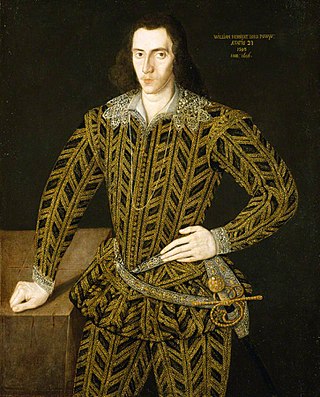Related Research Articles

Henry IV, also known as Henry Bolingbroke, was King of England from 1399 to 1413. He asserted the claim of his grandfather King Edward III, a maternal grandson of Philip IV of France, to the Kingdom of France. Henry was the first English ruler since the Norman Conquest, over three hundred years prior, whose mother tongue was English rather than French.

Geoffrey V, called the Handsome, the Fair or Plantagenet, was the count of Anjou, Touraine and Maine by inheritance from 1129, and also Duke of Normandy by conquest from 1144. His marriage to Empress Matilda, daughter of King Henry I of England, led to the centuries-long reign of the Plantagenet dynasty in England. The name "Plantagenet" was taken from Geoffrey's epithet. Geoffrey's ancestral domain of Anjou gave rise to the name Angevin, and what modern historians name as the Angevin Empire in the 12th century.

The House of Lancaster was a cadet branch of the royal House of Plantagenet. The first house was created when King Henry III of England created the Earldom of Lancaster—from which the house was named—for his second son Edmund Crouchback in 1267. Edmund had already been created Earl of Leicester in 1265 and was granted the lands and privileges of Simon de Montfort, 6th Earl of Leicester, after de Montfort's death and attainder at the end of the Second Barons' War. When Edmund's son Thomas, 2nd Earl of Lancaster, inherited his father-in-law's estates and title of Earl of Lincoln he became at a stroke the most powerful nobleman in England, with lands throughout the kingdom and the ability to raise vast private armies to wield power at national and local levels. This brought him—and Henry, his younger brother—into conflict with their cousin King Edward II, leading to Thomas's execution. Henry inherited Thomas's titles and he and his son, who was also called Henry, gave loyal service to Edward's son King Edward III.

Cecily Neville was an English noblewoman, the wife of Richard, Duke of York (1411–1460), and the mother of two kings of England—Edward IV and Richard III. Cecily Neville was known as "the Rose of Raby", because she was born at Raby Castle in Durham, and "Proud Cis", because of her pride and a temper that went with it, although she was also known for her piety. She herself signed her name "Cecylle".

Robert FitzRoy, 1st Earl of Gloucester was an illegitimate son of King Henry I of England. He was the half-brother of the Empress Matilda, and her chief military supporter during the civil war known as The Anarchy, in which she vied with Stephen of Blois for the throne of England.

Alice Perrers, also known as Alice de Windsor was an English royal mistress, lover of Edward III, King of England. As a result of his patronage, she became the wealthiest and most influential woman in the country. She was widely despised and accused of taking advantage of the old king.

The House of Stuart, originally spelt Stewart, was a royal house of Scotland, England, Ireland and later Great Britain. The family name comes from the office of High Steward of Scotland, which had been held by the family progenitor Walter fitz Alan. The name Stewart and variations had become established as a family name by the time of his grandson Walter Stewart. The first monarch of the Stewart line was Robert II, whose male-line descendants were kings and queens in Scotland from 1371, and of England, Ireland and Great Britain from 1603, until 1714. Mary, Queen of Scots, was brought up in France where she adopted the French spelling of the name Stuart.

William Longespée, 3rd Earl of Salisbury was an Anglo-Norman nobleman, primarily remembered for his command of the English forces at the Battle of Damme and for remaining loyal to his half-brother, King John. His nickname "Longespée" is generally taken as a reference to his great physical height and the oversize weapons that he used.

Edmund de Mortimer, 3rd Earl of March and jure uxoris Earl of Ulster was the son of Roger Mortimer, 2nd Earl of March, by his wife Philippa, daughter of William Montagu, 1st Earl of Salisbury and Catherine Grandison.

Henry FitzRoy, Duke of Richmond and Somerset,, was the son of King Henry VIII of England and his mistress, Elizabeth Blount, and the only child born out of wedlock whom Henry VIII acknowledged. He was the younger half-brother of Queen Mary I, as well as the older half-brother of Queen Elizabeth I and King Edward VI. Through his mother, he was the elder half-brother of the 4th Baroness Tailboys of Kyme and of the 2nd and 3rd Barons Tailboys of Kyme. He was named FitzRoy, which is derived from the Norman French term for "son of the king".

Joan of Portugal was the Queen of Castile as the second wife of King Henry IV of Castile. The posthumous daughter of King Edward of Portugal and Eleanor of Aragon, she was born in the Quinta do Monte Olivete Villa, Almada.

John Cornwall, 1st Baron Fanhope and Milbroke, KG, PC, also known as Sir John Cornwall, Sir John Cornwaille and Sir John Cornouayl, was an English nobleman, soldier and one of the most respected chivalric figures of his era.

William Douglas, 1st Earl of Douglas was a Scottish nobleman, peer, magnate, and head of the Black Douglas family. Under his leadership, the Black Douglases continued their climb to pre-eminence in Scottish politics begun under his uncle, Sir James the Good, as well as their military dominance of the south of Scotland.

Thomas Dacre, 2nd Baron Dacre of Gilsland, KG was the son of Humphrey Dacre, 1st Baron Dacre of Gilsland and Mabel Parr, great-aunt of queen consort Catherine Parr, the sixth and final wife of King Henry VIII of England. His mother was the daughter of Sir Thomas Parr of Kendal by his wife, Alice Tunstall.

Henry de Percy, 1st Baron Percy of Alnwick was a medieval English magnate.

William Herbert, 1st Baron Powis KB was a Welsh politician who sat in the House of Commons at various times between 1597 and 1629.
Ela of Salisbury, 3rd Countess of Salisbury was an English peeress. She succeeded to the title in her own right in 1196 upon the death of her father, William FitzPatrick, 2nd Earl of Salisbury.

John Montagu, 3rd Earl of Salisbury and 5th and 2nd Baron Montagu, KG was an English nobleman, one of the few who remained loyal to Richard II after Henry IV became king.

A royal bastard was a common term for the illegitimate child of a reigning monarch. These children were considered to be born outside of marriage - either because the monarch had an extra-marital affair, or because the legitimacy of the monarch's marriage had been called into question.
Richard of Lincoln was the illegitimate son of Henry I of England, born to Henry and a woman named Ansfride, widow of Aanskill. She is often referred to as Henry’s third mistress. Richard was brought up and educated by Robert Bloet, the Bishop of Lincoln. Bloet had also educated Richard’s half-brother Robert, 1st Earl of Gloucester. Richard is sometimes confused with Richard de Lincoln, an Anglo-Norman prelate who died in 1203.
References
- ↑ Hamilton, J.S. "The Plantagenets: History of a Dynasty" pg. 181
- ↑ Bertelli, Sergio "The King's Body: Sacred Rituals of Power in Medieval and Early Modern England" pg. 174
- ↑ Robertson, Ian "A Traveller's History of Portugal" pg. 56
- ↑ Harriss, G.L., Archer, Rowena E., and Walker, Simon "Rulers and Ruled in Late Medieval England" pp. 40 - 41